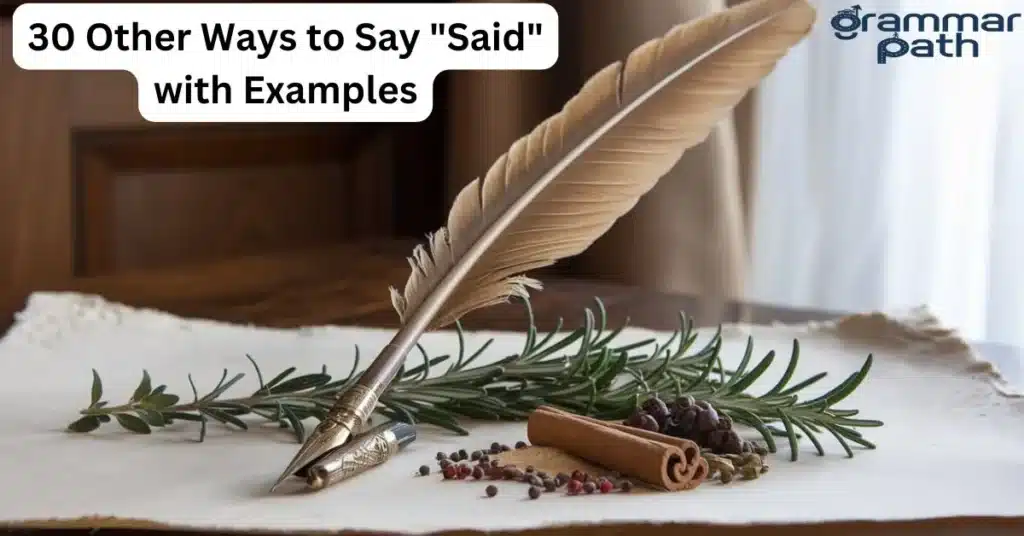
30 Other Ways to Say “Said” (With Example)
Other ways to say “said” can breathe life into your writing, especially when you want your characters to jump off the page. Instead of relying on the same dialogue tags over and over, it’s helpful to have a wide vocabulary to make conversations dynamic and engaging. Whether you’re writing fiction, emails, or blog posts, finding the right alternatives adds variety and depth to your work.
Dialogue tags play a significant role in storytelling, helping readers follow who’s speaking and how they feel. However, overusing the word “said” can make your writing feel monotonous. This article will explore 30 different words for said that you can use to diversify your writing and create more vivid conversations. You’ll not only learn new ways to express how something is said, but also get scenario examples that show each word in action.
We’ll also answer common questions such as, “Are dialogue tags always necessary?” and provide pro tips on how to swap out repetitive tags for stronger verbs or even actions. By the end, you’ll have a robust toolkit of words to keep your writing fresh, whether you’re writing a short story or an email.
is it Professional to Say: “Said”
Yes, using “said” is perfectly professional in most contexts, including formal writing. It’s clear, neutral, and doesn’t distract from the message.
However, overusing it in creative writing or dialogue-heavy content can become repetitive. In those cases, varying your dialogue tags with alternatives can add depth and nuance. Ultimately, the key is balance use “said” when it works, and switch it up when the situation calls for it.
What To Say Instead of “Said”
- Commanded
- Declared
- Responded
- Remarked
- Uttered
- Blurted
- Hissed
- Gushed
- Interjected
- Announced
What is a Dialogue Tag?
A dialogue tag is a word or phrase that indicates who is speaking in a dialogue. The most common dialogue tag is “said,” but as this article will explore, there are many alternatives to said that can help clarify tone, intention, and emotion. Dialogue tags are essential for guiding the reader, especially in long conversations, but they don’t always have to be repetitive.

Are Dialogue Tags Always Necessary?
Dialogue tags are helpful, but they aren’t always required. Sometimes, the context or the actions of a character can make it clear who’s speaking without needing a tag. For example:
“I can’t believe you did that!” Sarah crossed her arms and stared at him.
In this case, the dialogue tag “said” is unnecessary because the physical action and context show who is speaking. However, using other words for said in a story can add variety without confusing your readers.
Using Physical Actions Instead of Said
In certain situations, it’s more powerful to use a character’s actions rather than relying on a dialogue tag. Physical cues such as “sighed,” “laughed,” or “whispered” can paint a clearer picture of how the line is delivered. Let’s look at an example:
- Before:
“I don’t care anymore,” he said. - After:
“I don’t care anymore,” he whispered, his voice barely audible as he slumped into the chair.
The second version offers much more depth by combining a physical action with an alternative to “said.”
30 Other Ways to Say “Said” with Examples
Here are 30 alternatives to the word said, along with scenarios that show them in action:

- Replied
Example: “I’ll send over the files by noon,” John replied in his email. - Murmured
Example: “I don’t think that’s a good idea,” Emma murmured under her breath. - Exclaimed
Example: “We won!” Sarah exclaimed, her excitement palpable. - Whispered
Example: “Meet me by the park at midnight,” Tom whispered over the phone. - Barked
Example: “Get it done now!” the boss barked in his email to the team. - Answered
Example: “Yes, I already completed the task,” Linda answered during the meeting. - Shouted
Example: “Watch out!” Jake shouted as the car sped toward them. - Suggested
Example: “Maybe we should consider a different approach,” Rachel suggested in her blog post. - Admitted
Example: “I might have forgotten to send the email,” he admitted awkwardly. - Declared
Example: “From now on, we’re changing the process,” the CEO declared in the company-wide memo. - Asked
Example: “Can you help me with this?” she asked as she looked up from her desk. - Cried
Example: “Why would you do that?” Sarah cried, tears welling in her eyes. - Stated
Example: “The meeting will begin at 3 PM sharp,” the email from HR stated. - Laughed
Example: “You can’t be serious,” he laughed, shaking his head in disbelief. - Sobbed
Example: “I don’t know what to do anymore,” she sobbed, clutching the letter in her hands. - Groaned
Example: “Not again,” Tim groaned as his computer crashed for the third time that day. - Uttered
Example: “It’s not over yet,” she uttered, her voice barely above a whisper. - Muttered
Example: “This is ridiculous,” he muttered as he walked away from the argument. - Inquired
Example: “Did you finish the report?” Jason inquired during the team call. - Snapped
Example: “Enough already!” she snapped after hearing the same complaint for the third time.
10 More ways to say “Said”
- Growled
Example: “You better fix this,” he growled, his patience clearly wearing thin. - Yelled
Example: “I can’t believe it!” she yelled after finding out she got the promotion. - Explained
Example: “Here’s how the process works,” the manager explained during the training session. - Uttered
Example: “I hope we succeed,” she uttered, uncertainty clouding her tone. - Gasped
Example: “I can’t believe it!” Lisa gasped, her eyes wide in shock. - Chimed
Example: “I’d love to join,” Emily chimed in after hearing the plan. - Insisted
Example: “I’m not leaving without my book,” he insisted, standing his ground. - Roared
Example: “Victory is ours!” the general roared as the enemy retreated. - Confessed
Example: “I was wrong all along,” he confessed in his apology letter. - Promised
Example: “I’ll never let you down again,” she promised with a smile.
Pro Tips
The most important paragraph in this article is the list of 30 alternatives to said. Having a variety of synonyms at your disposal helps avoid redundancy and keeps your writing vibrant. Here are some tips on using them effectively:
- Match the emotion – Choose a tag that fits the tone of your dialogue. “Whispered” conveys something soft and secretive, while “shouted” brings energy and volume.
- Don’t overdo it – It’s important to use these alternatives sparingly. Too many different words can overwhelm your readers. Keep things balanced by using simple tags like “said” where it works, but sprinkle in the alternatives to add depth.
- Use context and action – You don’t always need a tag. Sometimes, physical actions or expressions can do the heavy lifting, eliminating the need for a dialogue tag entirely.
Frequently Asked Question
Q: Are alternatives to “said” always necessary?
A: No, using “said” is perfectly fine, but overuse can become repetitive. The goal is to mix things up without overcomplicating your writing.
Q: What are the best alternatives to “said” in formal writing?
A: In formal writing, words like “stated,” “declared,” or “replied” can maintain professionalism while avoiding overusing “said.”
Can using too many alternatives for “said” confuse readers?
A: Yes, overusing varied dialogue tags can overwhelm or distract readers. It’s best to use alternatives to “said” sparingly and only when it enhances the meaning or tone.
Q: What’s a good balance between using “said” and its synonyms?
A: Use “said” for clarity and flow, but sprinkle in alternatives to highlight emotion or specific character traits. A mix keeps the dialogue interesting without overcomplicating it.
Q: Are physical actions a good replacement for dialogue tags?
A: Absolutely. Physical actions can often replace a dialogue tag, showing emotion and reaction without needing extra words, making your writing more dynamic.
Conclusion
Finding other ways to say “said” can significantly elevate your writing, bringing more nuance and variety to your dialogue. By using alternatives that match the tone, emotion, and context of your characters’ speech, you keep your readers engaged and make your storytelling more dynamic. From simple synonyms like “replied” to more expressive ones like “growled” or “exclaimed,” each word choice adds its own layer of meaning.
Remember, while it’s great to expand your vocabulary, the key is balance. Sometimes, a plain “said” is all you need, and in other moments, a more specific tag can create a vivid picture in your reader’s mind. With the tools provided in this article, you’re now equipped to choose the best dialogue tags for any situation—whether you’re writing a novel, an email, or crafting dialogue for a blog.

Emily Olivia is an experienced writer specializing in grammar and English language topics. With a passion for clarity and precision, she shares valuable insights on synonyms, grammar rules, and writing tips to help readers enhance their language skills on Grammar Path.





